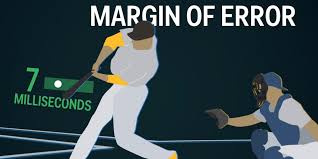Tuesday, 9 January 2018
The Baseball Batter’s Predictive Brain

For some years now, cognitive scientists have increasingly come to regard the human brain as a machine for making predictions. In other words, these scientists think that our brains spend most of their time trying to figure out what is going to happen next so that they can take action accordingly. The great adaptive value of such a process is immediately obvious.
The theoretical framework underlying this view of things is extensive and fairly new, although it has roots in 18th-century philosophy. Some authors even describe it as a paradigm shift, the same term that has been applied in turn to the cognitivist, connectionist and embodied dynamic approaches over the past half-century. But these models involve Bayesian probabilities and cannot be readily expressed in simpler terms, much to my own dismay (I’d like to write about them more often in this blog, but don’t always manage to).
In any case, recently I came across a video that’s scarcely two minutes long and at first glance has nothing to do with this new paradigm but actually presents its fundamentals in a highly concrete way by addressing the following question: how do professional baseball players manage to hit a fastball? The adjective “professional” is important here, because it’s what make this seemingly simple question so complicated. When a professional pitcher throws a fastball, it is travelling about 95 miles (150 km) per hour at the time of release and has only 55 feet (slightly less than 17 m) to go before reaching the catcher’s mitt. This means that the ball covers this distance in just 400 milliseconds.
As the video explains, the batter’s visual system needs nearly 100 milliseconds to process any stimulus. If the batter decides to swing, it will then take 25 milliseconds for the motor commands from the batter’s brain to reach the batter’s muscles, and an average of 150 milliseconds for the batter to swing the bat. Subtract those three numbers from 400, and that leaves the batter only 125 milliseconds to decide whether to swing at the pitch. That’s an extremely short reaction time—as the video points out, it takes you 300 to 400 milliseconds just to blink your eyes. So how, then, do professional baseball players still manage to hit fair balls so often?
The answer can be summed up in a single word: anticipation. As the video explains, this anticipation takes at least two forms. First, the batter can try to get a head start by beginning to swing when there is still very little information about the path that the ball is going to travel. But the batter can’t start to swing too early, because after about 50 milliseconds, the bat’s inertia will make it impossible for the batter to check (stop) the swing.
The other form of anticipation at work here is the one that involves the “predictive brain”: our spontaneous ability to predict what is likely to happen on the basis of our past interactions with the world, which are encoded in the brain as a priori models. In the present case, the brain can anticipate the position of a moving target from cues inside an extremely short time window. This principle is well illustrated in the video by the “flash drag” effect, in which the direction in which the background is moving causes the viewer to perceive the positions of the red and blue dots incorrectly (offset in the direction in which the background is moving rather than in their true position).
And the same phenomenon is at work when a batter successfully uses the bat to make contact with the the ball. The batter’s brain starts to anticipate the ball’s trajectory before it has even left the pitcher’s hand, simply from the dynamics of the pitcher’s movement. Then the ball’s trajectory over the first few metres after the pitcher releases it provides further information that the batter’s brain can use to predict the ultimate position of this moving object. The bottom line: with a lot of training, a professional baseball player’s brain can successfully perform a task that would appear to be physically impossible!
Body Movement and the Brain | No comments







